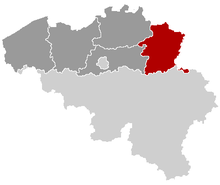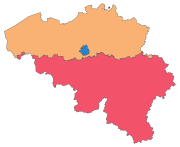Limburg (Belgium)
| (Dutch: Limburg) | |
 |
|
| Country | |
| Region | |
| Capital | Hasselt |
| Area | 2,414 km² |
| Population 1/1/2008 | 826,690 |
| Density | 333 / km² |
| Governor | Herman Reynders |
 |
|
| Official Site | |
- This article deals with a province in Belgium. For other uses of Limburg, see: Limburg. For the town of Limbourg or Limburg in Belgium, see: Limbourg
Limburg (Dutch: Limburg) is the easternmost province of Flanders (which is one of the three regions of Belgium), and is located west of the Maas river. It borders on (clockwise from the North) the Dutch provinces of North Brabant and Limburg and the Belgian provinces of Liège, Flemish Brabant and Antwerp. Its capital is Hasselt. It has an area of 2,414 km² which is divided into three Arrondissements (arrondissementen in Dutch) containing 44 municipalities. Among them is Genk, one of the economical centres of the province. An educational centre, as a result of the presence of a university, is Diepenbeek near Hasselt.
Contents |
History
Governors since 1815
The following list contains all governors of the province of Limburg since 1815.[1]
- Herman Reynders, governor of Limburg from 5 October 2009 until present (°1958)
- Steve Stevaert, governor of Limburg from 1 June 2005 until 15 June 2009 (° 1954)
- Hilde Houben-Bertrand, governor of Limburg from 1995 until 2005 (° 1940)
- Harry Vandermeulen, gouvernor of the king from 1978 until 1995 (°1928)
- Louis Roppe, gouvernor of the king from 1950 until 1978 (°1914 - +1982)
- Interruption due to World War II
- Jozef Lysens, governor of Limburg from 1941 until 1944 (°1896 - +1950)
- Ghislain Romsée, governor of Limburg from 1940 until 1941 (°1901 - +1976)
- Hubert Verwilghen, governor of Limburg from 1928 until 1940 (°1883 - +1955)
- Graaf Theodore de Renesse, governor of Limburg from 1917 until 1927 (°1845 - +1927)
- Henri Theodore Jules de Pitteurs-Hiégaerts, governor of Limburg from 1894 until 1914 (°1834 - +1917)
- Adolphe Goupy de Beauvolers, governor of Limburg from 1879 until 1894 (°1825 - +1894)
- Joseph Bovy, governor of Limburg from 1872 until 1879 (°1810 - +1879)
- Pierre Jacques François de Decker, gouvernor of Limburg in 1871 (°1812 - +1891)
- Theodoor de T'Serclaes de Wommersom, governor of Limburg from 1857 until 1871 (°1809 - +1880)
- Pierre Leonard Louis Marie baron de Schiervel, governor of Limburg from 1843 until 1857 (°1783 - +1866)
- Werner de Lamberts, governor of Limburg from 1834 until 1843 (°1775-1849)
- Jean-François Hennequin, governor of Limburg from 1831 until 1934 (°1772 - +1846)
- Frans de Loë, governor of Limburg from 1830 until 1831 (°1789 - +1838)
- Maximilien de Beeckman, governor of Limburg from 1828 until 1830 (°1781 - +1834)
- Charles de Brouckère, governor of Limburg from 1815 until 1828 (°1757 - +1850)
Language
As in all Flemish provinces, the official language is Dutch, but two municipalities: Herstappe and Voeren are to a certain extent allowed to use French to communicate with their citizens; these are called the municipalities with language facilities.
Geography
Belgian Limburg is crossed by the Albert Canal, and has historically been a major coal-mining area. North of the Albert Canal and the river Demer, is the Campine region, with sandy soils, bush, forests and the coal-mining area. South of the Albert Canal and the river Demer, is the Hesbaye region, with fertile soils, farming and fruit. In the southeast also more low hills.
History
Limburg's name derives from the fortified castle town known as Limbourg, situated on the river Vesdre in the Ardennes, now in the Walloon province of Liège. It was the seat of the medieval Duchy of Limburg which extended into the Meuse region north of the city of Liège. However, most the area of the current Dutch Limburg was not part of this polity but was divided among several states including the Duchy of Brabant, the Duchy of Jülich, and the Bishopric of Liège, as well as the Duchy of Limburg. A result of this division is still evident in the plethora of distinct varieties of the Limburgish language spoken in Limburg municipalities.
Following the Napoleonic Era, the great powers (United Kingdom, Prussia, Austrian Empire, Russian Empire, and France) united the region with the new United Kingdom of the Netherlands in 1815. A new province was formed and was to receive the name "Maastricht", after its capital. The first king, William I, who did not want the name Limbourg to be lost, insisted that the name be changed to "Limburg". As such, the name of the new province derived from the old Duchy of Limburg that had existed until 1648 within the triangle of Maastricht, Liège, and Aachen.
When the Catholic South, both the Dutch and French speaking regions, split away from the mainly Calvinist, Dutch North in the Belgian Revolution of 1830, the province of Limburg was at first almost entirely under Belgian rule. In 1839 Limburg was split into so-called Dutch Limburg and Belgian Limburg, though it became Flemish when all provinces in Belgium came under control of institutional regions.
Limburg mijn Vaderland is the official anthem of both Belgian and Dutch Limburg.
Economy
- Ford Automobile Factory in Genk
- Philips Research
- Belgium's fruit producing region Haspengouw (Hesbaye) is predominantly situated in Limburg.
- Chemical industry
- Tourism
Administrative divisions

|
Arrondissement Hasselt: |
Arrondissement Maaseik: |
Arrondissement Tongeren: |
Not to be confused with, though related to, the Dutch province of Limburg.
Famous Limburgers
- Willy Claes (1938) - Politician; former Secretary General of NATO.
- Robert Cailliau, (1947) - Co-inventor of the World Wide Web, together with Tim Berners-Lee.
- Adrien de Gerlache - former Antarctica explorer
- Barthélémy de Theux de Meylandt (1794-1874) - Politician; former Prime Minister
- Neel Doff (1858-1942) - Writer
- Hendrik van Veldeke (1858-1942) - First writer from the Low Countries known by name (c. 1140-c. 1190)
- Ambiorix (1st century B.C.) - leader of the Gaulish Eburones against Julius Caesar.
- Stijn Helsen (1973) - Fashion designer.
Sports & Entertainment
- Ingrid Berghmans (1961) - Former judo world champion
- Kim Clijsters - Tennis player
- Tom Boonen - Road cyclist, 2005 world champion.
- Harry Everts - Former motocross world champion
- Stefan Everts - Former motocross world champion
- Eric Geboers - Former motocross world champion
- Eric Gerets - Former soccer player
- Karel Lismont - Former athlete
- Jacky Martens - Former motocross world champion
- Axelle Red - Singer
- Eric Vanderaerden (1962) - Former cyclist
- Ingrid Vandebosch- model and married to NASCAR driver Jeff Gordon
Design
- Casimir (furniture designer)
- Jan van Eyck (ca.1390-1441) - Flemish painter
Leeglappen
- Nicky Max - Leeglap in Appie, Lanaken.
Circuit
An internationally well known Limburgian place is Zolder, where racing circuit Terlamen is located, on which in the past among others two Worldchampionships in roadcycling were held, as well as several Formula one car races.
References
- ↑ (Dutch) Gouverneurs van 1815 tot nu, limburg.be
See also
- Limburgish language
- List of Governors of Limburg, Belgium
- Limburg (Netherlands), a province in southeastern Netherlands.
- Hesbaye
- CIPAL
- Campine
- Limburg Science Park
|
||||||||||||||||||||||||||||||||||||||||||||

